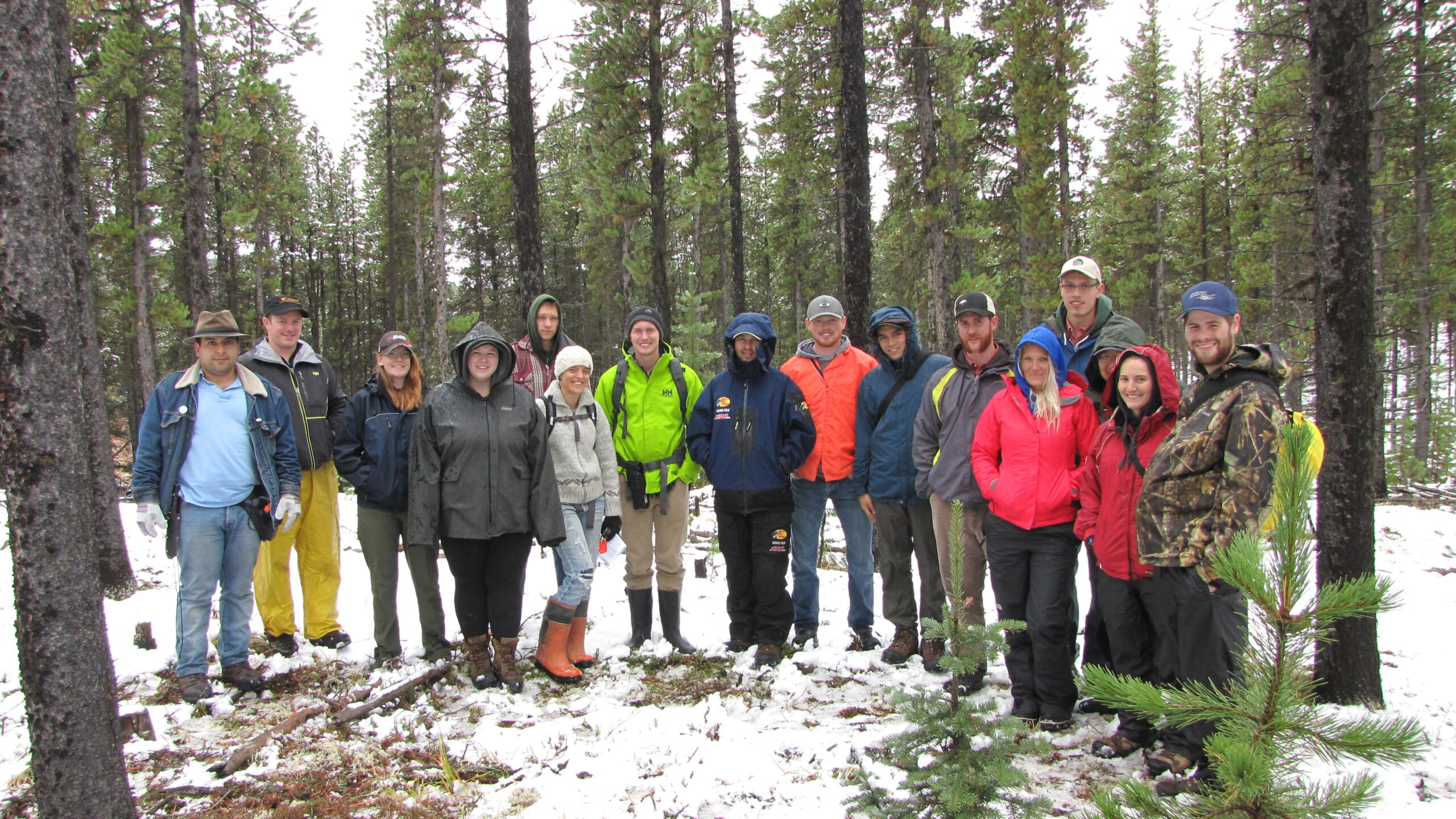Determining the importance of grizzly bear predation on southern mountain caribou populations
This project will look at the impact of grizzly bears on caribou populations in west-central Alberta, and to also develop new techniques to measure and monitor bear predation levels on caribou populations. Results will help land and resource managers understand and better mitigate impacts that forestry activities are having on grizzly bear and caribou habitat, and any mortality risk that brings.
Background
Caribou and grizzly bears are symbols of the wilderness, highly valued by Albertans for their recreational opportunities, and recognized as indicators of ecosystem health and function. Southern mountain caribou in Alberta are designated as a Threatened species at the provincial (Alberta’s Wildlife Act) and federal levels (COSEWIC and SARA). Resource extraction activities have been implicated as the causal mechanism driving predator prey dynamics between caribou and wolves (James and Stuart-Smith, 2000; Dyer et al., 2001). Timber harvesting results in a preponderance of early seral stage forest that creates conditions leading to an increase in alternative prey species (moose, elk, and deer) and consequently a numerical response in predators (Latham et al., 2011, 2013; Whittington et al., 2011; Peters et al., 2012). This, coupled with oil and gas development that produces linear features (seismic lines, pipelines, and roads) within intact mature forest increases predator efficiency across the landscape (DeCesare 2012) that further compounds the predation problem (Dyer et al., 2001; James and Stuart-Smith, 2000; Whittington et al., 2011). As a means to reduce predators within caribou ranges, the provincial government conducts an aggressive wolf cull program each winter. However, predators such as bears and cougars may also be impacting caribou populations (Bergerud and Elliot 1986; Kinley and Apps, 2001; Gustine et al., 2006), which could also be linked to timber harvest and/or the creation of linear features within mature forest. Management of caribou populations could benefit from further investigation of alternative predators. This project will attempt to look at the impact of grizzly bears may be having on caribou populations.
Researchers from other jurisdictions (Alaska and Yukon) have shown that bears can have an important impact on the survival rate of ungulate calves, but little data is available to quantify if grizzly bears are having a similar effect on caribou herds in Alberta. The primary reason for this lack of data is the difficulty and cost of gathering the information where grizzly bears occur at low densities in remote habitats. We believe that new techniques are needed to allow for non-invasive monitoring of grizzly bear predation on caribou. With recent advances in stable isotope analysis it is now possible to understand more about bear diets than previously envisioned. As it is necessary to validate field data with laboratory experiments when conducting isotope studies of animal diet (Hobson and Clark, 1992), we propose to conduct directed feeding studies with captive grizzly bears to determine if it is possible to measure and quantify the level of caribou in the diet by sampling grizzly bear hair.
The information disseminated from this research project is vital to the effective conservation, management, and recovery of both caribou and grizzly bear as they coexist on the broader landscape where forest harvesting and other industrial development is planned or has occurred. The data, knowledge and new techniques derived from our research project will be important to FMA holders, government agencies and other stakeholders who will benefit from a more complete understanding of the possible predation effects grizzly bears have on caribou populations. This work will also investigate the potential linkages between grizzly bear predation events and landscape conditions associated with forest management and habitat requirements for two important species at risk in Alberta. This improved understanding will be important in order to guide recovery actions for both caribou and grizzly bears and to enable forest planners to further understand predator prey dynamics in the context of integrated land use planning.
Objectives and Methods
The goal of this project is to determine to what extent grizzly bear predation might be influencing caribou populations in west-central Alberta using existing datasets supplemented with additional key data not currently available, and to also develop new techniques to measure and monitor bear predation levels on caribou populations.
We will utilize multiple data sources including GPS locations, kill site investigations, and stable isotopes from existing and newly acquired data sets collected as part of this project to meet the following objectives:
Objective 1: Develop habitat use models of caribou and grizzly bear in relation to each other and anthropogenic features.
Methods: We will determine habitat use and movement patterns of caribou and grizzly bear in relation to each other and anthropogenic features using currently established Resource Selection Function models (Nielsen et al. 2002, 2006, DeCesare et al. 2012).
Objective 2: Model the probability of caribou mortality by grizzly bears and assess variation associated with biological factors and landscape characteristics.
Methods: Field crews will visit suspected collared caribou mortality locations to determine cause of mortality immediately following mortality signal (<48hrs), and GPS location clusters (suspected kill sites) of collared grizzly bears will also be visited. These data will be used to develop predation probability models and to investigate variation related to biological factors (sex-age class, reproductive status), seasonality, anthropogenic features and other habitat characteristics.
Objective 3: Feeding trials to validate and assess the amount of caribou in the diet of grizzly bear using stable isotopes found in bear hair
Methods: We will conduct feeding trials (Robbins et al., 2009) to determine if stable isotopes can be used to detect reindeer in the diet of bears from hair samples. Questions relating to the amount of reindeer meat consumed and the time to deposition of an isotope signature will be investigated. We will also determine if moose, and elk meat show up in our isotope analysis of hair.
Field crew begin colllaring grizzly bears May and June
Field crew investigates GPS clusters to look for signs of predation
Another wave of bears are collared, bringing the total to 14
Field crews visted more GPS clusters, bringing the total total to 448
An update on the first year’s data is released
Analysis underway to prepare the publication of the full results
Project completed with the release of the project’s findings




Bergerud, A. T. and J. P. Elliot. 1986. Dynamics of caribou and wolves in northern British Columbia. Canadian Journal of zoology 64:1515–1529.
DeCesare, N. J. 2012. Separating spatial search and efficiency rates as components of predation risk. Proceedings. Biological sciences / The Royal Society 279:4626–33.
DeCesare, N. J., M. Hebblewhite, F. Schmiegelow, D. Hervieux, G. J. McDermid, L. Neufeld, M. Bradley, J. Whittington, K. Smith, L. E. Morgantini, M. Wheatley and M. Musiani. 2012. Transcending scale dependence in identifying habitat with resource selection functions. Ecological Applications 22:1068–1083.
Dyer, S., J. O’Neill, S. Wasel and S. Boutin. 2001. Avoidance of industrial development by woodland caribou. The Journal of Wildlife Management 65:531–542.
Gustine, D. D., K. L. Parker, R. J. Lay, M. P. Gillingham and D. C. Heard. 2006. Calf Survival of Woodland Caribou in a Multi-Predator Ecosystem. Wildlife Monographs 165:1–32.
Hilderbrand, G. V., S. D. Farley, C. T. Robbins, T. A. Hanley, K. Titus and C. Servheen. 1996. Use of stable isotopes to determine diets of living and extinct bears. Canadian Journal of Zoology 74(11): 2080-2088.
Florin, S.T., L.A. Felicetti, and C.T. Robbins. 2011. The biological basis for understanding and predicting dietary-induced variation in nitrogen and sulphur isotope ratio discrimination. Functional Ecology 25(3): 519-526.
James, A. R. C. and A. K. Stuart-Smith. 2000. Distribution of caribou and wolves in relation to linear corridors. The Journal of Wildlife Management 64:154–159.
Kinley, A. and D. Apps. 2001. Mortality patterns in a subpopopulation of endangered mountain caribou. Wildlife Society Bulletin 29:158–164.
Latham, A. D. M., M. C. Latham, M. S. Boyce and S. Boutin. 2011a. The Role of Predation in Woodland Caribou Population Declines in Northeastern Alberta- Coyotes. A report prepared for the Alberta Upstream Petroleum Research Fund, Petroleum Technology Alliance of Canada, June 2011. AUPRF Report: Coyote Expansion into Woodland Caribou Range.
Latham, A. D. M., M. C. Latham, M. S. Boyce and S. Boutin. 2011b. Movement responses by wolves to industrial linear features and their effect on woodland caribou in northeastern Alberta. Ecological Applications 21:2854–2865.
Milakovic, B. and K. L. Parker. 2011. Using stable isotopes to define diets of wolves in northern British Columbia, Canada. Journal of Mammalogy 92(2): 295-304.
Nielsen, S. E., M. S. Boyce, G. B. Stenhouse and R. H. M. Munro. 2002. Modeling grizzly bear habitats in the Yellowhead ecosystem of Alberta: taking autocorrelation seriously. Ursus 13:45–56.
Nielsen 2006, Seasonal grizzly bear habitat for six population units of Alberta, Canada. In: Stenhouse, G. and K. Graham (eds). Foothills Model Forest Grizzly Bear Research Program 2006 Annual Report. Hinton, Alberta. 87 pp.
Peters, W., M. Hebblewhite, N. DeCesare, F. Cagnacci and M. Musiani. 2013. Resource separation analysis with moose indicates threats to caribou in human altered landscapes. Ecography 36:487–498.
Robbins, C.T., L.A. Felicetti, and M. Sponheimer. 2005. The effect of dietary protein quality on nitrogen isotope discrimination in mammals and birds. Oecologia 144(4): 534-540.
Robbins, C., J. K. Fortin, K. D. Rode, S. D. Farley, L. A. Shipley, L. A. Felicetti, C. T. Robbins, J. K. Kortin, K. D. Rode, S. D. Farley, L. A. Shipley and L. A. Felicetti. 2007. Optimizing protein intake as a foraging strategy to maximize mass gain in an omnivore. Oikos 116:1675–1682.
Whittington, J., M. Hebblewhite, N. J. DeCesare, L. Neufeld, M. Bradley, J. Wilmshurst and M. Musiani. 2011. Caribou encounters with wolves increase near roads and trails: a time-to-event approach. Journal of Applied Ecology 48:1535–1542.
Young, D. D. and T. R. Mccabe. 1997. Grizzly bear predation rates on caribou calves in northeastern Alaska. Journal of Wildlife Management 61:1056–1066.







